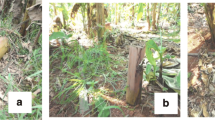Abstract
Attraction of Metamasius hemipterus (Oliver) to gallon and bamboo traps baited with insecticide-treated sugarcane, the male-produced pheromone, 4-methyl-5-nonanol, and 2-methyl-4-heptanol is more efficient if ethyl acetate is added. The optimal traps are ground-level gallon traps baited with insecticide-laced sugarcane, pheromone, and ethyl acetate. Capture rates of ground-level gallon traps are doubled by placing an insecticide-laced pad under the trap, but significantly decreased by placing the trap on a stick above ground. The efficiency of ground-level gallon traps is the same as ground level ramp traps. Mass-trapping M. hemipterus in newly planted sugarcane using ground level bamboo traps baited with insecticide-laced sugarcane and pheromone over six months revealed populations were low for the first two months, became maximum at five months, and declined thereafter. Capture rates of traps bordering newly planted and mature sugarcane were not significantly different from capture rates of traps in the interior of the plots. Capture rates of bamboo traps containing only insecticide-laced sugarcane and deployed at 30 traps/ha averaged 6 weevils/trap/week compared with 66 weevils/trap/week for traps additionally containing pheromone lures and deployed at 5 traps/ha. Capture rates for bamboo traps baited with insecticide-laced sugarcane and pheromone and deployed at 10 and 15 traps/ha were 43 and 38 weevils/trap/week, respectively. Total captures were higher in those plots with a higher density of insecticide-laden sugarcane and pheromone baited traps, and the differences were approximately proportional to trap density in the range of 5–15 traps/ha. Capture rates of traps containing insecticide-laced sugarcane and pheromone were always higher than of traps containing only insecticide-laced sugarcane, but in the first two months after planting the differences were much greater than in months 3–6 after planting.
Similar content being viewed by others
REFERENCES
Alpizar, D., Fallas, M., Oehlschlager, A. C., Gonzalez, L. M., and Jayaraman S. 2000. Pheromone-based mass trapping of the banana weevil, Cosmopolites sordidus (Germar) in plantain and banana. Association for Cooperation in Banana Research in the Caribbean and Tropical America Biannual Conference, San Juan, Puerto Rico, July 25- 31.
Badilla, F., Barquero, E., and Vargas, N. 1985. Conozo y combata el picudo rayado una plaga de importancia en el cultivo de la caña de azucar. Boletin Informativo No. 31, Direccion de Investigacion y Extension de la Caña de Azucar, San Jose, Costa Rica, 4 pp. 1664 OEHLSCHLAGER ET AL.
Cerda, H., Fernandez, G., Lopez, A., and Varga, J. 1999. Olfactory attraction of the sugar cane weevil (Coleoptera: Curculionidae) to host plant odors and its aggregation pheromone.Fla. Entomol. 81:103–112.
Giblin-Davis, R. M., PeÑa, J. E., Oehlschlager, A. C., and Perez, A. L. 1996. Optimization of a semiochemical-based trapping system for Metamasius hemipterus sericeus (Oliver) (Coleoptera: Curculionidae).J. Chem. Ecol. 22:1389–1410.
McDonald, R. S., Saenz, E. E., Oehlschlager, A. C., Gonzalez, L. M., and Andrade, R. 1996. Improved capture of adult Metamasius hemipterus sericus in sugarcane in Costa Rica with synthetic male-produced aggregation pheromone, 10th Congreso de Camara de Productores de Caña del Pacifico, Guanacaste, Costa Rica, September 5- 7, 1996, pp. 86–90.
Oehlschlager, A. C., Chinchila, C. M. Gonzalez, L. M. Jiron, L. F., Mexzon, R., and Morgan, B. 1993a. Development of a pheromone-based trapping system for Rhynchophorus palmarum (Coleoptera: Curculionidae). J. Econ. Entomol. 86:1381–1392.
Oehlschlager, A. C., Chinchilla, C. M., and Gonzalez, L. M. 1993b. Optimization of a pheromone-baited trap for the American palm weevil Rhynchophorus palmarum (L.). Proceedings of Palm Oil Research Institute of Malaysia International Palm Oil Congress, Kuala Lumpur, Malaysia, September, pp. A645–A660.
Oehlschlager, A. C., McDonald, R. S., Chinchilla, C. M., and Patschke, S. N. 1995. Influence of a pheromone-based mass-trapping system on the distribution of Rhynchophorus palmarum (Coleoptera: Curculionidae) in oil palm. Environ. Entomol. 24:1005–1012.
PEREZ, A. L., Campos-Pedra, Y., Chinchilla, C. M., Gries, G., Gries, R., Pierce, H. D., Jr., Gonzalez, L. M., Oehlschlager, A. C., Castrillo, G., McDonald, R. S., Giblin-Davis, R. M., PeÑa, J. E., Duncan, R. E., and Andrade, R. 1997. Aggregation pheromones and host kairomones of the West Indian sugarcane weevil, Metamasius hemipterus sericeus (Oliver). J. Chem. Ecol. 23:869- 888.
Ramirez-Lucas, P., Rochat, D., and Zagatti, P. 1996. Field trapping of Metamasius hemipterus with synthetic aggregation pheromone. Entomol. Exp. Appl. 80:453–460.
Author information
Authors and Affiliations
Corresponding author
Rights and permissions
About this article
Cite this article
Oehlschlager, A.C., Gonzalez, L., Gomez, M. et al. Pheromone-Based Trapping of West Indian Sugarcane Weevil in a Sugarcane Plantation. J Chem Ecol 28, 1653–1664 (2002). https://doi.org/10.1023/A:1019936831696
Issue Date:
DOI: https://doi.org/10.1023/A:1019936831696




